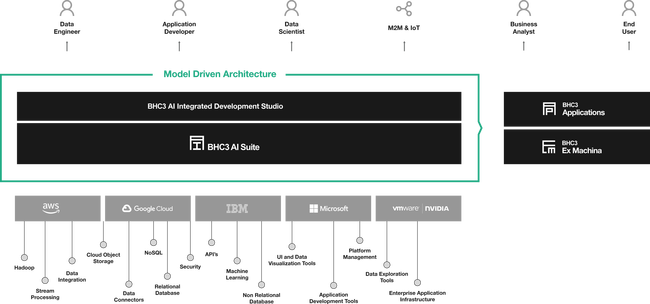Model Driven Architecture
The BHC3™ AI Suite uses a unique model-driven architecture to accelerate delivery and reduce the complexities of developing enterprise AI applications. The BHC3 AI model-driven architecture provides an “abstraction layer,” that allows developers to build enterprise AI applications by using conceptual models of all the elements an application requires, instead of writing lengthy code. This provides significant benefits:
Scale AI Across the Business
Use AI applications and models that optimize processes for every product, asset, customer, or transaction across all regions and businesses
Deliver Results in 1-2 Quarters
Deploy AI applications and see results in 1-2 quarters – rapidly roll out additional applications and new capabilities
Generate Meaningful Value
Unlock sustained value – hundreds of millions to billions of dollars per year – from reduced costs, increased revenue, and higher margins
Govern AI with Confidence
Ensure systematic, enterprise-wide governance of AI with the BHC3 unified platform that offers data lineage and model governance
Enterprise AI applications typically require numerous underlying elements – such as data persistence services, data streaming services, messaging services, analytics services, machine learning services, security services, and dozens or hundreds more. With a traditional structured programing approach, developers must devote significant time and effort in writing extensive code to define, manage, connect, and control each element. This results in overwhelming complexity and highly brittle applications that can break any time an underlying element is changed or updated – a primary reason why the vast majority of enterprise AI efforts fail.

By contrast, the BHC3 AI Suite model-driven architecture provides an “abstraction layer,” that allows developers to build Enterprise AI applications by using conceptual models of all the elements an application requires, instead of writing lengthy code. BHC3 provides thousands of pre-built conceptual models that can be easily modified and extended, and developers can efficiently create their own models as well. These pre-built, extensible models encompass a vast range of entities, including business objects (customer, order, contract, etc.), physical systems and subsystems (engine, boiler, chiller, compressor, etc.), computing resources and services (database, stream processing, etc.) – anything at all that an application requires, can be represented as a model in the model-driven architecture. To ensure ongoing operability of BHC3’s thousands of prebuilt and extensible models on different underlying infrastructure (e.g., AWS, Azure, etc.), BHC3 runs tens of thousands of automated tests and security scans any time a change or update is made to the infrastructure.
The model-driven architecture enables the use of “declarative programming,” an efficient approach that essentially allows programmers to specify what they want the application to do, without having to write explicit code on how to do it. Compared to traditional structured programming, the model-driven architecture and declarative programming shortens time to value and reduces total cost of ownership. Leveraging this model-driven architecture, application developers and data scientists can focus on delivering immediate value, without the need to manage the complexities of the underlying elements. These conceptual models can also be used by many applications, further accelerating development of new applications.
Enterprise Wide Collaboration
- Model-driven architecture serves as an object-centric abstraction layer removing complexities and barriers across developers, data scientists, and business end users.
- Enhanced collaboration across development teams and business end users through object representation of the business problem.
- Improved adoption and understanding of AI across the enterprise.
Accelerated Time-to-Value
- Model-driven architecture enables application developers and data scientists to focus on delivering immediate value, without the need to learn, integrate, or understand the complexities of the underlying systems.
- 18x or more faster application development and production deployment timelines vs. alternative technologies.
- Future-proof applications with simplified maintenance requirements.
Scalability
- Application development with 99% less code, significantly fewer resources, and reduced maintenance requirements.
- Massively expandable architecture across applications and the enterprise.
- Unmatched flexibility and scalability through reusability of object models developed on the BHC3 AI Suite.


